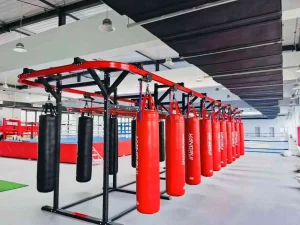ਮੁੱਕੇਬਾਜ਼ੀ ਇੱਕ ਲੜਾਈ ਵਾਲੀ ਖੇਡ ਹੈ ਜੋ ਸਰੀਰਕ ਧੀਰਜ ਅਤੇ ਮਾਨਸਿਕ ਲਚਕੀਲੇਪਣ ਦੋਵਾਂ ਦੀ ਮੰਗ ਕਰਦੀ ਹੈ। ਭਾਵੇਂ ਤੁਸੀਂ ਇੱਕ ਲੜਾਈ ਖੇਡ ਸਕੂਲ, ਮਾਰਸ਼ਲ ਆਰਟਸ ਅਕੈਡਮੀ, ਜਾਂ ਇੱਕ ਸਮਰਪਿਤ ਬਾਕਸਿੰਗ ਜਿਮ ਹੋ, ਦੀ ਬਣਤਰ ਅਤੇ ਮਹੱਤਤਾ ਨੂੰ ਸਮਝਦੇ ਹੋ ਮੁੱਕੇਬਾਜ਼ੀ ਦੌਰ ਕੁਲੀਨ ਲੜਾਕਿਆਂ ਨੂੰ ਸਿਖਲਾਈ ਦੇਣ ਲਈ ਜ਼ਰੂਰੀ ਹੈ। ਇਹ ਵਿਆਪਕ ਗਾਈਡ ਮੁੱਕੇਬਾਜ਼ੀ ਦੌਰ ਦੀਆਂ ਪੇਚੀਦਗੀਆਂ ਦੀ ਪੜਚੋਲ ਕਰਦੀ ਹੈ, ਤੁਹਾਡੇ ਸਿਖਲਾਈ ਪ੍ਰੋਗਰਾਮਾਂ ਨੂੰ ਵਧਾਉਣ ਅਤੇ ਪੇਸ਼ੇਵਰ ਮੁੱਕੇਬਾਜ਼ੀ ਦੀ ਮੰਗ ਵਾਲੀ ਦੁਨੀਆ ਲਈ ਲੜਾਕਿਆਂ ਨੂੰ ਤਿਆਰ ਕਰਨ ਲਈ ਕੀਮਤੀ ਸੂਝ ਪ੍ਰਦਾਨ ਕਰਦੀ ਹੈ।
ਇੱਕ ਮੁੱਕੇਬਾਜ਼ੀ ਦੌਰ ਕੀ ਹੈ?
ਏ ਮੁੱਕੇਬਾਜ਼ੀ ਦੌਰ ਮੈਚ ਦਾ ਇੱਕ ਢਾਂਚਾਗਤ ਖੰਡ ਹੈ ਜਿੱਥੇ ਦੋ ਲੜਾਕੇ ਰਿੰਗ ਦੇ ਅੰਦਰ ਲੜਾਈ ਵਿੱਚ ਸ਼ਾਮਲ ਹੁੰਦੇ ਹਨ। ਹਰ ਦੌਰ ਆਮ ਤੌਰ 'ਤੇ ਰਹਿੰਦਾ ਹੈ ਤਿੰਨ ਮਿੰਟ, ਉਸ ਤੋਂ ਬਾਅਦ ਏ ਇੱਕ ਮਿੰਟ ਦੀ ਆਰਾਮ ਦੀ ਮਿਆਦ. ਇਹ ਚੱਕਰੀ ਬਣਤਰ ਦੁਆਰਾ ਨਿਯੰਤਰਿਤ ਕੀਤਾ ਜਾਂਦਾ ਹੈ ਕਵੀਂਸਬੇਰੀ ਨਿਯਮ, ਜੋ ਖੇਡ ਵਿੱਚ ਨਿਰਪੱਖਤਾ ਅਤੇ ਸੁਰੱਖਿਆ ਨੂੰ ਯਕੀਨੀ ਬਣਾਉਂਦੇ ਹਨ।
ਇੱਕ ਮੁੱਕੇਬਾਜ਼ੀ ਦੌਰ ਦੇ ਮੁੱਖ ਤੱਤ:
- ਮਿਆਦ: ਸਰਗਰਮ ਲੜਾਈ ਦੇ 3 ਮਿੰਟ.
- ਆਰਾਮ ਦੀ ਮਿਆਦ: ਗੇੜਾਂ ਵਿਚਕਾਰ 1 ਮਿੰਟ।
- ਬਣਤਰ: WBC, WBA, ਅਤੇ IBF ਵਰਗੀਆਂ ਸੰਸਥਾਵਾਂ ਦੁਆਰਾ ਨਿਗਰਾਨੀ ਕੀਤੇ ਗਏ ਸਾਰੇ ਪ੍ਰਵਾਨਿਤ ਮੈਚਾਂ ਦੁਆਰਾ ਪਾਲਣਾ ਕੀਤੀ ਜਾਂਦੀ ਹੈ।
ਹਰੇਕ ਦੌਰ ਦੀ ਗਤੀਸ਼ੀਲਤਾ ਨੂੰ ਸਮਝਣਾ ਲੜਾਕੂਆਂ ਅਤੇ ਕੋਚਾਂ ਨੂੰ ਪ੍ਰਦਰਸ਼ਨ ਨੂੰ ਅਨੁਕੂਲ ਬਣਾਉਣ, ਊਰਜਾ ਭੰਡਾਰਾਂ ਦਾ ਪ੍ਰਬੰਧਨ ਕਰਨ ਅਤੇ ਪੂਰੇ ਮੈਚ ਦੌਰਾਨ ਪ੍ਰਭਾਵਸ਼ਾਲੀ ਰਣਨੀਤੀਆਂ ਨੂੰ ਲਾਗੂ ਕਰਨ ਦੀ ਇਜਾਜ਼ਤ ਦਿੰਦਾ ਹੈ।
ਇੱਕ ਪੇਸ਼ੇਵਰ ਮੁੱਕੇਬਾਜ਼ੀ ਮੈਚ ਵਿੱਚ ਕਿੰਨੇ ਰਾਉਂਡ ਹੁੰਦੇ ਹਨ?

ਏ ਵਿੱਚ ਰਾਊਂਡਾਂ ਦੀ ਗਿਣਤੀ ਪੇਸ਼ੇਵਰ ਮੁੱਕੇਬਾਜ਼ੀ ਮੈਚ ਮੁਕਾਬਲੇ ਦੀ ਮਹੱਤਤਾ ਅਤੇ ਦਾਅ 'ਤੇ ਆਧਾਰਿਤ ਵੱਖ-ਵੱਖ ਹੁੰਦਾ ਹੈ।
ਮਿਆਰੀ ਦੌਰ ਗਿਣਤੀ:
- ਗੈਰ-ਟਾਈਟਲ ਲੜਾਈਆਂ: ਤੋਂ ਆਮ ਤੌਰ 'ਤੇ ਸੀਮਾ 4 ਤੋਂ 10 ਦੌਰ.
- ਟਾਈਟਲ ਲੜਾਈਆਂ: ਤੱਕ ਵਧਾਓ 12 ਦੌਰ.
- ਇਤਿਹਾਸਕ ਮੈਚ: ਮਹਾਨ ਮੁਕਾਬਲੇ, ਜਿਵੇਂ ਕਿ ਉਹ ਸ਼ਾਮਲ ਹਨ ਮਾਈਕ ਟਾਇਸਨ, ਤੀਬਰ ਪ੍ਰਦਰਸ਼ਨ ਕੀਤਾ ਹੈ 12-ਗੇੜ ਲੜਾਈਆਂ ਜੋ ਲੜਾਕਿਆਂ ਨੂੰ ਉਹਨਾਂ ਦੀਆਂ ਸੀਮਾਵਾਂ ਤੱਕ ਧੱਕਦੀਆਂ ਹਨ।
ਪੇਸ਼ੇਵਰ ਮੁੱਕੇਬਾਜ਼ੀ ਵਿੱਚ ਮਿਆਰੀ ਦੌਰ ਦੀ ਗਿਣਤੀ
| ਮੈਚ ਦੀ ਕਿਸਮ | ਦੌਰ ਦੀ ਸੰਖਿਆ |
|---|---|
| ਗੈਰ-ਟਾਈਟਲ ਲੜਾਈਆਂ | 4-10 ਦੌਰ |
| ਟਾਈਟਲ ਲੜਾਈਆਂ | 12 ਰਾਊਂਡ ਤੱਕ |
| ਪ੍ਰਦਰਸ਼ਨੀ ਮੈਚ | ਬਦਲਦਾ ਹੈ |
ਰਾਊਂਡਾਂ ਦੀ ਸੰਖਿਆ ਨੂੰ ਸਮਝਣਾ ਲੜਾਕਿਆਂ ਲਈ ਆਪਣੇ ਸਿਖਲਾਈ ਦੇ ਨਿਯਮਾਂ ਨੂੰ ਅਨੁਕੂਲ ਬਣਾਉਣ ਲਈ ਮਹੱਤਵਪੂਰਨ ਹੈ, ਲੰਬੇ ਮੁਕਾਬਲੇ ਵਿੱਚ ਵਧੀਆ ਪ੍ਰਦਰਸ਼ਨ ਕਰਨ ਲਈ ਧੀਰਜ ਅਤੇ ਰਣਨੀਤਕ ਪੈਸਿੰਗ 'ਤੇ ਧਿਆਨ ਕੇਂਦਰਤ ਕਰਦਾ ਹੈ।
ਇੱਕ ਲੜਾਕੂ ਦੀ ਰਣਨੀਤੀ ਵਿੱਚ ਦੌਰ ਦੀ ਭੂਮਿਕਾ
ਹਰ ਗੇੜ ਲੜਾਕਿਆਂ ਲਈ ਆਪਣੀਆਂ ਰਣਨੀਤੀਆਂ ਨੂੰ ਲਾਗੂ ਕਰਨ ਅਤੇ ਆਪਣੇ ਵਿਰੋਧੀ ਦੀਆਂ ਚਾਲਾਂ ਦੇ ਅਨੁਕੂਲ ਹੋਣ ਦਾ ਇੱਕ ਵਿਲੱਖਣ ਮੌਕਾ ਪੇਸ਼ ਕਰਦਾ ਹੈ। ਦੀ ਬਣਤਰ ਬਹੁਤ ਸਾਰੇ ਦੌਰ ਇੱਕ ਮੈਚ ਵਿੱਚ ਇਹ ਪ੍ਰਭਾਵਿਤ ਕਰਦਾ ਹੈ ਕਿ ਲੜਾਕੂ ਮੁਕਾਬਲੇ ਦੇ ਹਰੇਕ ਹਿੱਸੇ ਤੱਕ ਕਿਵੇਂ ਪਹੁੰਚਦੇ ਹਨ।
ਰਣਨੀਤਕ ਵਿਚਾਰ:
- ਸ਼ੁਰੂਆਤੀ ਦੌਰ: ਦਬਦਬਾ ਸਥਾਪਤ ਕਰਨਾ, ਵਿਰੋਧੀ ਦੀਆਂ ਸ਼ਕਤੀਆਂ ਅਤੇ ਕਮਜ਼ੋਰੀਆਂ ਦਾ ਪਤਾ ਲਗਾਉਣਾ।
- ਮੱਧ ਦੌਰ: ਗਤੀ ਵਧਾਉਣਾ, ਦਬਾਅ ਵਧਾਉਣਾ, ਅਤੇ ਯੋਜਨਾਬੱਧ ਸੰਜੋਗਾਂ ਨੂੰ ਲਾਗੂ ਕਰਨਾ।
- ਅੰਤਿਮ ਦੌਰ: ਇੱਕ ਨਿਰਣਾਇਕ ਸਮਾਪਤੀ ਲਈ ਊਰਜਾ ਭੰਡਾਰ ਨੂੰ ਵੱਧ ਤੋਂ ਵੱਧ ਕਰਨਾ ਜਾਂ ਪੁਆਇੰਟਾਂ 'ਤੇ ਜਿੱਤ ਪ੍ਰਾਪਤ ਕਰਨ ਲਈ ਬਚਾਅ ਨੂੰ ਕਾਇਮ ਰੱਖਣਾ।
“ਬਾਕਸਿੰਗ ਵਿੱਚ, ਹਰ ਦੌਰ ਦੀ ਗਿਣਤੀ ਹੁੰਦੀ ਹੈ। ਇਹ ਸਿਰਫ਼ ਲੈਂਡਿੰਗ ਪੰਚਾਂ ਬਾਰੇ ਨਹੀਂ ਹੈ ਬਲਕਿ ਪੂਰੇ ਮੈਚ ਦੌਰਾਨ ਤੁਹਾਡੀ ਊਰਜਾ ਅਤੇ ਰਣਨੀਤੀ ਦਾ ਪ੍ਰਬੰਧਨ ਕਰਨਾ ਹੈ।”
- ਮਾਈਕ ਟਾਇਸਨ, ਮਹਾਨ ਮੁੱਕੇਬਾਜ਼
ਕਈ ਗੇੜਾਂ ਵਿੱਚ ਪ੍ਰਭਾਵਸ਼ਾਲੀ ਰਣਨੀਤੀ ਇਹ ਯਕੀਨੀ ਬਣਾਉਂਦੀ ਹੈ ਕਿ ਲੜਾਕੂ ਅਨੁਕੂਲ ਅਤੇ ਲਚਕੀਲੇ ਬਣੇ ਰਹਿਣ, ਮੈਚ ਦੀ ਵਿਕਾਸਸ਼ੀਲ ਗਤੀਸ਼ੀਲਤਾ ਦੇ ਅਧਾਰ 'ਤੇ ਆਪਣੀਆਂ ਰਣਨੀਤੀਆਂ ਨੂੰ ਅਨੁਕੂਲ ਕਰਨ ਦੇ ਸਮਰੱਥ।
ਸ਼ੁਕੀਨ ਬਨਾਮ ਪੇਸ਼ੇਵਰ ਮੁੱਕੇਬਾਜ਼ੀ: ਦੌਰ ਵਿੱਚ ਅੰਤਰ

ਜਦੋਂ ਕਿ ਦੋਵੇਂ ਸ਼ੁਕੀਨ ਅਤੇ ਪੇਸ਼ੇਵਰ ਮੁੱਕੇਬਾਜ਼ੀ ਉਹੀ ਬੁਨਿਆਦੀ ਨਿਯਮਾਂ ਨੂੰ ਸਾਂਝਾ ਕਰਦੇ ਹਨ, ਉਹ ਰਾਊਂਡਾਂ ਦੀ ਗਿਣਤੀ ਅਤੇ ਮੁਕਾਬਲੇ ਦੇ ਫੋਕਸ ਵਿੱਚ ਕਾਫ਼ੀ ਭਿੰਨ ਹੁੰਦੇ ਹਨ।
ਤੁਲਨਾ: ਸ਼ੁਕੀਨ ਬਨਾਮ ਪੇਸ਼ੇਵਰ ਮੁੱਕੇਬਾਜ਼ੀ
| ਪਹਿਲੂ | ਸ਼ੁਕੀਨ ਮੁੱਕੇਬਾਜ਼ੀ | ਪੇਸ਼ੇਵਰ ਮੁੱਕੇਬਾਜ਼ੀ |
|---|---|---|
| ਦੌਰ ਦੀ ਸੰਖਿਆ | 3 ਦੌਰ | 12 ਰਾਊਂਡ ਤੱਕ |
| ਦੌਰ ਦੀ ਮਿਆਦ | 3 ਮਿੰਟ | 3 ਮਿੰਟ |
| ਫੋਕਸ | ਸਪੀਡ ਅਤੇ ਤਕਨੀਕ | ਧੀਰਜ ਅਤੇ ਸ਼ਕਤੀ |
| ਸਕੋਰਿੰਗ ਸਿਸਟਮ | ਬਿੰਦੂ-ਅਧਾਰਿਤ, ਤਕਨੀਕ-ਕੇਂਦ੍ਰਿਤ | ਅੰਕ ਅਤੇ ਨਾਕਆਊਟ |
ਮੁੱਖ ਅੰਤਰ:
- ਸ਼ੁਕੀਨ ਮੁੱਕੇਬਾਜ਼ੀ: ਸੱਟ ਦੇ ਖਤਰੇ ਨੂੰ ਘਟਾਉਣ ਲਈ ਛੋਟੇ ਮੈਚਾਂ ਦੇ ਨਾਲ, ਤਾਕਤ ਤੋਂ ਵੱਧ ਗਤੀ, ਚੁਸਤੀ ਅਤੇ ਤਕਨੀਕ 'ਤੇ ਜ਼ੋਰ ਦਿੰਦਾ ਹੈ।
- ਪੇਸ਼ੇਵਰ ਮੁੱਕੇਬਾਜ਼ੀ: ਧੀਰਜ, ਸ਼ਕਤੀ ਅਤੇ ਰਣਨੀਤਕ ਪੈਸਿੰਗ 'ਤੇ ਧਿਆਨ ਕੇਂਦਰਤ ਕਰਦਾ ਹੈ, ਲੰਬੇ ਮੈਚਾਂ ਦੇ ਨਾਲ ਜੋ ਇੱਕ ਲੜਾਕੂ ਦੀ ਸਹਿਣਸ਼ੀਲਤਾ ਅਤੇ ਲਚਕੀਲੇਪਨ ਦੀ ਜਾਂਚ ਕਰਦੇ ਹਨ।
ਇਹਨਾਂ ਅੰਤਰਾਂ ਲਈ ਲੜਾਕੂਆਂ ਨੂੰ ਉਹਨਾਂ ਦੀਆਂ ਸਬੰਧਤ ਮੁੱਕੇਬਾਜ਼ੀ ਸ਼੍ਰੇਣੀਆਂ ਦੀਆਂ ਖਾਸ ਮੰਗਾਂ ਲਈ ਤਿਆਰ ਕਰਨ ਲਈ ਅਨੁਕੂਲ ਸਿਖਲਾਈ ਪ੍ਰੋਗਰਾਮਾਂ ਦੀ ਲੋੜ ਹੁੰਦੀ ਹੈ।
ਰਾਉਂਡ ਇੱਕ ਮੁੱਕੇਬਾਜ਼ ਦੇ ਧੀਰਜ ਨੂੰ ਕਿਵੇਂ ਪ੍ਰਭਾਵਿਤ ਕਰਦੇ ਹਨ?
ਧੀਰਜ ਮੁੱਕੇਬਾਜ਼ੀ ਦੇ ਪ੍ਰਦਰਸ਼ਨ ਦਾ ਆਧਾਰ ਹੈ, ਖਾਸ ਤੌਰ 'ਤੇ ਕਈ ਦੌਰ ਦੇ ਮੈਚਾਂ ਵਿੱਚ। ਊਰਜਾ ਨੂੰ ਕਾਇਮ ਰੱਖਣ ਅਤੇ ਸਾਰੇ ਗੇੜਾਂ ਦੌਰਾਨ ਪ੍ਰਦਰਸ਼ਨ ਨੂੰ ਬਰਕਰਾਰ ਰੱਖਣ ਦੀ ਯੋਗਤਾ ਲੜਾਈ ਦੇ ਨਤੀਜੇ ਨੂੰ ਨਿਰਧਾਰਤ ਕਰ ਸਕਦੀ ਹੈ।
ਧੀਰਜ 'ਤੇ ਦੌਰ ਦਾ ਪ੍ਰਭਾਵ:
- ਕਾਰਡੀਓਵੈਸਕੁਲਰ ਸਟੈਮਿਨਾ: ਊਰਜਾ ਦੇ ਪੱਧਰ ਨੂੰ ਉੱਚਾ ਰੱਖਣ ਲਈ ਕਈ ਦੌਰਾਂ ਨੂੰ ਲਗਾਤਾਰ ਕਾਰਡੀਓਵੈਸਕੁਲਰ ਜਤਨਾਂ ਦੀ ਲੋੜ ਹੁੰਦੀ ਹੈ।
- ਮਾਸਪੇਸ਼ੀ ਸਹਿਣਸ਼ੀਲਤਾ: ਲਗਾਤਾਰ ਪੰਚਿੰਗ ਅਤੇ ਰੱਖਿਆਤਮਕ ਅਭਿਆਸ ਮਜ਼ਬੂਤ ਮਾਸਪੇਸ਼ੀ ਸਹਿਣਸ਼ੀਲਤਾ ਦੀ ਮੰਗ ਕਰਦੇ ਹਨ।
- ਮਾਨਸਿਕ ਸਥਿਰਤਾ: ਰਣਨੀਤਕ ਐਗਜ਼ੀਕਿਊਸ਼ਨ ਲਈ ਬਹੁਤ ਸਾਰੇ ਦੌਰ ਵਿੱਚ ਫੋਕਸ ਅਤੇ ਸੰਜਮ ਬਣਾਈ ਰੱਖਣਾ ਮਹੱਤਵਪੂਰਨ ਹੈ।
ਸਹਿਣਸ਼ੀਲਤਾ ਸਿਖਲਾਈ ਸੁਝਾਅ:
- ਅੰਤਰਾਲ ਸਿਖਲਾਈ: ਰਿੰਗ ਵਿੱਚ ਲੋੜੀਂਦੀ ਊਰਜਾ ਦੇ ਫਟਣ ਦੀ ਨਕਲ ਕਰਨ ਲਈ ਉੱਚ-ਤੀਬਰਤਾ ਅੰਤਰਾਲ ਸਿਖਲਾਈ (HIIT) ਨੂੰ ਸ਼ਾਮਲ ਕਰੋ।
- ਲੰਬੀ ਦੂਰੀ ਦੀ ਦੌੜ: ਸਥਿਰ-ਰਾਜ ਕਾਰਡੀਓ ਅਭਿਆਸਾਂ ਦੁਆਰਾ ਕਾਰਡੀਓਵੈਸਕੁਲਰ ਸਮਰੱਥਾ ਬਣਾਓ।
- ਤਾਕਤ ਕੰਡੀਸ਼ਨਿੰਗ: ਪ੍ਰਤੀਰੋਧਕ ਸਿਖਲਾਈ ਅਤੇ ਸਰੀਰ ਦੇ ਭਾਰ ਦੇ ਅਭਿਆਸਾਂ ਨਾਲ ਮਾਸਪੇਸ਼ੀ ਸਹਿਣਸ਼ੀਲਤਾ ਬਣਾਉਣ 'ਤੇ ਧਿਆਨ ਕੇਂਦਰਤ ਕਰੋ।
ਸਿਖਲਾਈ ਵਿੱਚ ਸਹਿਣਸ਼ੀਲਤਾ ਨੂੰ ਤਰਜੀਹ ਦੇ ਕੇ, ਲੜਾਕੇ ਵਿਸਤ੍ਰਿਤ ਮੈਚਾਂ ਦੀਆਂ ਸਰੀਰਕ ਅਤੇ ਮਾਨਸਿਕ ਮੰਗਾਂ ਨੂੰ ਬਿਹਤਰ ਢੰਗ ਨਾਲ ਪ੍ਰਬੰਧਿਤ ਕਰ ਸਕਦੇ ਹਨ, ਪਹਿਲੇ ਤੋਂ ਆਖ਼ਰੀ ਦੌਰ ਤੱਕ ਸਿਖਰ ਪ੍ਰਦਰਸ਼ਨ ਨੂੰ ਯਕੀਨੀ ਬਣਾ ਸਕਦੇ ਹਨ।
ਚੈਂਪੀਅਨਸ਼ਿਪ ਦੌਰ ਦਾ ਪ੍ਰਭਾਵ
ਚੈਂਪੀਅਨਸ਼ਿਪ ਮੁਕਾਬਲੇ ਇੱਕ ਮੁੱਕੇਬਾਜ਼ ਦੇ ਕੈਰੀਅਰ ਦੇ ਸਿਖਰ ਨੂੰ ਦਰਸਾਉਂਦੇ ਹੋਏ, ਅਕਸਰ ਪੂਰੇ 12 ਗੇੜਾਂ ਤੱਕ ਵਧਾਉਂਦੇ ਹਨ। ਇਹ ਮੈਚ ਨਾ ਸਿਰਫ਼ ਹੁਨਰ ਦੀ ਪਰੀਖਿਆ ਹਨ, ਸਗੋਂ ਸਹਿਣਸ਼ੀਲਤਾ, ਰਣਨੀਤੀ ਅਤੇ ਮਾਨਸਿਕ ਮਜ਼ਬੂਤੀ ਦੇ ਵੀ ਹਨ।
ਚੈਂਪੀਅਨਸ਼ਿਪ ਦੌਰ ਵਿੱਚ ਮੁੱਖ ਕਾਰਕ:
- ਮਾਨਸਿਕ ਕਠੋਰਤਾ: ਲੜਾਕਿਆਂ ਨੂੰ ਬਹੁਤ ਜ਼ਿਆਦਾ ਦਬਾਅ ਹੇਠ ਕੇਂਦ੍ਰਿਤ ਅਤੇ ਤਿਆਰ ਰਹਿਣਾ ਚਾਹੀਦਾ ਹੈ।
- ਸਰੀਰਕ ਕੰਡੀਸ਼ਨਿੰਗ: ਚੰਗੀ ਕਾਰਗੁਜ਼ਾਰੀ ਵਿੱਚ ਕਮੀ ਦੇ ਬਿਨਾਂ ਲੰਬੀ ਲੜਾਈ ਨੂੰ ਸਹਿਣ ਲਈ ਪੀਕ ਫਿਟਨੈਸ ਪੱਧਰ ਜ਼ਰੂਰੀ ਹਨ।
- ਰਣਨੀਤਕ ਅਨੁਕੂਲਤਾ: ਚੈਂਪੀਅਨਸ਼ਿਪ ਦਾ ਖਿਤਾਬ ਹਾਸਲ ਕਰਨ ਲਈ ਵਿਰੋਧੀ ਦੇ ਪ੍ਰਦਰਸ਼ਨ ਦੇ ਆਧਾਰ 'ਤੇ ਰਣਨੀਤੀਆਂ ਨੂੰ ਅਨੁਕੂਲ ਕਰਨ ਦੀ ਸਮਰੱਥਾ ਮਹੱਤਵਪੂਰਨ ਹੈ।
ਕੇਸ ਉਦਾਹਰਨ:
ਕਥਾਵਿਚ ਮਾਈਕ ਟਾਇਸਨ ਲੜਾਈਆਂ, ਤੀਬਰ 12-ਰਾਉਂਡ ਦੀਆਂ ਲੜਾਈਆਂ ਨੇ ਦਿਖਾਇਆ ਕਿ ਕਿਵੇਂ ਉੱਤਮ ਕੰਡੀਸ਼ਨਿੰਗ ਅਤੇ ਰਣਨੀਤਕ ਯੋਜਨਾਬੰਦੀ ਪ੍ਰਭਾਵਸ਼ਾਲੀ ਪ੍ਰਦਰਸ਼ਨ ਦੀ ਅਗਵਾਈ ਕਰ ਸਕਦੀ ਹੈ, ਇੱਥੋਂ ਤੱਕ ਕਿ ਜ਼ਬਰਦਸਤ ਵਿਰੋਧੀਆਂ ਦੇ ਵਿਰੁੱਧ ਵੀ।
ਚੈਂਪੀਅਨਸ਼ਿਪ ਦੌਰ ਦੀ ਤਿਆਰੀ ਲਈ ਇੱਕ ਵਿਆਪਕ ਸਿਖਲਾਈ ਪਹੁੰਚ ਦੀ ਲੋੜ ਹੁੰਦੀ ਹੈ ਜੋ ਇੱਕ ਲੜਾਕੂ ਦੇ ਪ੍ਰਦਰਸ਼ਨ ਦੇ ਸਾਰੇ ਪਹਿਲੂਆਂ ਨੂੰ ਸੰਬੋਧਿਤ ਕਰਦਾ ਹੈ, ਇਹ ਯਕੀਨੀ ਬਣਾਉਂਦਾ ਹੈ ਕਿ ਉਹ ਟਾਈਟਲ ਬਾਊਟ ਦੀਆਂ ਮੰਗਾਂ ਨੂੰ ਸੰਭਾਲਣ ਲਈ ਚੰਗੀ ਤਰ੍ਹਾਂ ਤਿਆਰ ਹਨ।
ਰਾਊਂਡ ਦੇ ਵਿਚਕਾਰ ਆਰਾਮ ਦੀ ਮਿਆਦ ਦੇ ਦੌਰਾਨ ਕੀ ਹੁੰਦਾ ਹੈ?
ਦ ਇੱਕ ਮਿੰਟ ਦੀ ਆਰਾਮ ਦੀ ਮਿਆਦ ਰਾਉਂਡ ਦੇ ਵਿਚਕਾਰ ਇੱਕ ਮੁੱਕੇਬਾਜ਼ੀ ਮੈਚ ਵਿੱਚ ਕਈ ਨਾਜ਼ੁਕ ਫੰਕਸ਼ਨਾਂ ਦੀ ਸੇਵਾ ਕਰਦਾ ਹੈ, ਜਿਸ ਨਾਲ ਲੜਾਕੂਆਂ ਨੂੰ ਆਗਾਮੀ ਦੌਰ ਲਈ ਰਿਕਵਰੀ ਅਤੇ ਰਣਨੀਤੀ ਬਣਾਉਣ ਲਈ ਲੋੜੀਂਦਾ ਸਮਾਂ ਮਿਲਦਾ ਹੈ।
ਆਰਾਮ ਦੇ ਸਮੇਂ ਦੌਰਾਨ ਗਤੀਵਿਧੀਆਂ:
- ਹਾਈਡ੍ਰੇਸ਼ਨ: ਲੜਾਕੂ ਹਾਈਡਰੇਸ਼ਨ ਪੱਧਰਾਂ ਨੂੰ ਬਣਾਈ ਰੱਖਣ ਲਈ ਗੁੰਮ ਹੋਏ ਤਰਲ ਪਦਾਰਥਾਂ ਨੂੰ ਭਰ ਦਿੰਦੇ ਹਨ।
- ਕੋਚਿੰਗ ਫੀਡਬੈਕ: ਟ੍ਰੇਨਰ ਪਿਛਲੇ ਦੌਰ ਦੇ ਪ੍ਰਦਰਸ਼ਨ ਦੇ ਆਧਾਰ 'ਤੇ ਤੁਰੰਤ ਫੀਡਬੈਕ ਅਤੇ ਰਣਨੀਤਕ ਵਿਵਸਥਾ ਪ੍ਰਦਾਨ ਕਰਦੇ ਹਨ।
- ਮਾਨਸਿਕ ਤਿਆਰੀ: ਲੜਾਕੇ ਮਾਨਸਿਕ ਤੌਰ 'ਤੇ ਰੀਸੈਟ ਕਰਦੇ ਹਨ, ਤਕਨੀਕਾਂ ਦੀ ਕਲਪਨਾ ਕਰਦੇ ਹਨ ਅਤੇ ਅਗਲੇ ਦੌਰ ਦੀਆਂ ਚੁਣੌਤੀਆਂ ਲਈ ਤਿਆਰੀ ਕਰਦੇ ਹਨ।
ਆਰਾਮ ਦੇ ਸਮੇਂ ਦੀ ਮਹੱਤਤਾ:
- ਰਿਕਵਰੀ: ਲੜਾਕਿਆਂ ਨੂੰ ਪਿਛਲੇ ਦੌਰ ਦੀ ਸਰੀਰਕ ਮਿਹਨਤ ਤੋਂ ਥੋੜ੍ਹਾ ਠੀਕ ਹੋਣ ਦੀ ਆਗਿਆ ਦਿੰਦਾ ਹੈ।
- ਰਣਨੀਤੀ ਸੁਧਾਰ: ਸਮੁੱਚੀ ਲੜਾਈ ਰਣਨੀਤੀ ਨੂੰ ਵਧਾਉਂਦੇ ਹੋਏ, ਰਣਨੀਤੀਆਂ ਵਿੱਚ ਅਸਲ-ਸਮੇਂ ਦੇ ਸਮਾਯੋਜਨ ਨੂੰ ਸਮਰੱਥ ਬਣਾਉਂਦਾ ਹੈ।
- ਫੋਕਸ ਮੇਨਟੇਨੈਂਸ: ਲੜਾਕਿਆਂ ਨੂੰ ਪੂਰੇ ਮੈਚ ਦੌਰਾਨ ਮਾਨਸਿਕ ਤੌਰ 'ਤੇ ਤਿੱਖੇ ਅਤੇ ਫੋਕਸ ਰਹਿਣ ਵਿੱਚ ਮਦਦ ਕਰਦਾ ਹੈ।
ਆਰਾਮ ਦੀ ਮਿਆਦ ਦੀ ਪ੍ਰਭਾਵੀ ਵਰਤੋਂ ਇੱਕ ਘੁਲਾਟੀਏ ਦੇ ਪ੍ਰਦਰਸ਼ਨ ਨੂੰ ਮਹੱਤਵਪੂਰਨ ਤੌਰ 'ਤੇ ਵਧਾ ਸਕਦੀ ਹੈ, ਇਹ ਯਕੀਨੀ ਬਣਾਉਂਦਾ ਹੈ ਕਿ ਉਹ ਨਵੀਂ ਊਰਜਾ ਅਤੇ ਰਣਨੀਤਕ ਸਪੱਸ਼ਟਤਾ ਨਾਲ ਹਰ ਦੌਰ ਨਾਲ ਨਜਿੱਠਣ ਲਈ ਤਿਆਰ ਹਨ।
ਕੇਸ ਸਟੱਡੀ: ਪਾਲ ਫਾਈਟ ਅਤੇ ਇਸਦੇ ਕਈ ਦੌਰ
ਦ ਜੇਕ ਪਾਲ ਲੜਾਈ ਇਸ ਗੱਲ ਦੀ ਇੱਕ ਸਮਕਾਲੀ ਉਦਾਹਰਣ ਵਜੋਂ ਕੰਮ ਕਰਦੀ ਹੈ ਕਿ ਕਿਵੇਂ ਲੜਾਕੂ ਕਈ ਦੌਰ ਦੇ ਨਾਲ ਇੱਕ ਪੇਸ਼ੇਵਰ ਮੁੱਕੇਬਾਜ਼ੀ ਮੈਚ ਦੀਆਂ ਜਟਿਲਤਾਵਾਂ ਨੂੰ ਨੈਵੀਗੇਟ ਕਰਦੇ ਹਨ। ਪੇਸ਼ੇਵਰ ਮੁੱਕੇਬਾਜ਼ੀ ਵਿੱਚ ਨਵੇਂ ਆਉਣ ਦੇ ਬਾਵਜੂਦ, ਜੇਕ ਪੌਲ ਦੇ ਮੁਕਾਬਲੇ ਨੇ ਲੜਾਈ ਦੇ ਨਤੀਜੇ ਨੂੰ ਨਿਰਧਾਰਤ ਕਰਨ ਵਿੱਚ ਰਣਨੀਤੀ, ਧੀਰਜ ਅਤੇ ਅਨੁਕੂਲਤਾ ਦੇ ਮਹੱਤਵ ਨੂੰ ਉਜਾਗਰ ਕੀਤਾ ਹੈ।
ਪੌਲ ਫਾਈਟ ਤੋਂ ਇਨਸਾਈਟਸ:
- ਰਣਨੀਤਕ ਪੈਸਿੰਗ: ਜੇਕ ਪੌਲ ਨੇ ਸ਼ੁਰੂਆਤੀ ਬਰਨਆਊਟ ਤੋਂ ਬਿਨਾਂ ਲਗਾਤਾਰ ਪ੍ਰਦਰਸ਼ਨ ਨੂੰ ਕਾਇਮ ਰੱਖਦੇ ਹੋਏ, ਸਾਰੇ ਦੌਰ ਵਿੱਚ ਆਪਣੀ ਊਰਜਾ ਨੂੰ ਪ੍ਰਭਾਵਸ਼ਾਲੀ ਢੰਗ ਨਾਲ ਪ੍ਰਬੰਧਿਤ ਕੀਤਾ।
- ਅਨੁਕੂਲਤਾ: ਵਿਰੋਧੀ ਦੀਆਂ ਸ਼ਕਤੀਆਂ ਦੇ ਅਧਾਰ 'ਤੇ ਵਿਵਸਥਿਤ ਰਣਨੀਤੀਆਂ, ਲੜਾਈ ਦੇ ਵਿਚਕਾਰ ਰਣਨੀਤੀਆਂ ਨੂੰ ਅਨੁਕੂਲ ਬਣਾਉਣ ਦੀ ਯੋਗਤਾ ਦਾ ਪ੍ਰਦਰਸ਼ਨ ਕਰਦੇ ਹੋਏ।
- ਧੀਰਜ: ਧੀਰਜ ਦੇ ਉੱਚ ਪੱਧਰਾਂ ਦਾ ਪ੍ਰਦਰਸ਼ਨ ਕੀਤਾ, ਮੈਚ ਦੇ ਦੌਰਾਨ ਪ੍ਰਦਰਸ਼ਨ ਦੀ ਇਕਸਾਰਤਾ ਨੂੰ ਕਾਇਮ ਰੱਖਿਆ।
ਮੁੱਖ ਉਪਾਅ:
- ਤਿਆਰੀ: ਵਿਆਪਕ ਸਿਖਲਾਈ ਦੀਆਂ ਵਿਧੀਆਂ ਜੋ ਸਰੀਰਕ ਅਤੇ ਮਾਨਸਿਕ ਦੋਵਾਂ ਪਹਿਲੂਆਂ 'ਤੇ ਧਿਆਨ ਕੇਂਦ੍ਰਤ ਕਰਦੀਆਂ ਹਨ ਮਲਟੀ-ਰਾਊਂਡ ਬਾਊਟਸ ਵਿੱਚ ਸਫਲਤਾ ਲਈ ਜ਼ਰੂਰੀ ਹਨ।
- ਰਣਨੀਤੀ ਲਾਗੂ ਕਰਨਾ: ਲੜਾਕਿਆਂ ਨੂੰ ਮੈਚ ਦੇ ਪ੍ਰਵਾਹ ਅਤੇ ਵਿਰੋਧੀ ਦੇ ਵਿਵਹਾਰ ਦੇ ਆਧਾਰ 'ਤੇ ਆਪਣੀਆਂ ਰਣਨੀਤੀਆਂ ਨੂੰ ਅਨੁਕੂਲ ਕਰਨ ਵਿੱਚ ਮਾਹਰ ਹੋਣਾ ਚਾਹੀਦਾ ਹੈ।
- ਸਹਿਣਸ਼ੀਲਤਾ ਦੀ ਸੰਭਾਲ: ਜਿੱਤ ਪ੍ਰਾਪਤ ਕਰਨ ਲਈ ਊਰਜਾ ਦੇ ਪੱਧਰਾਂ ਅਤੇ ਪ੍ਰਦਰਸ਼ਨ ਦੀ ਇਕਸਾਰਤਾ ਨੂੰ ਕਈ ਗੇੜਾਂ ਵਿੱਚ ਕਾਇਮ ਰੱਖਣਾ ਮਹੱਤਵਪੂਰਨ ਹੈ।
ਪੌਲ ਫਾਈਟ ਇਹ ਦਰਸਾਉਂਦੀ ਹੈ ਕਿ ਕਿਵੇਂ ਆਧੁਨਿਕ ਮੁੱਕੇਬਾਜ਼ ਕਈ ਦੌਰਾਂ ਦੇ ਨਾਲ ਪੇਸ਼ੇਵਰ ਮੁੱਕੇਬਾਜ਼ੀ ਮੈਚਾਂ ਵਿੱਚ ਉੱਤਮ ਹੋਣ ਲਈ ਰਣਨੀਤਕ ਯੋਜਨਾਬੰਦੀ ਅਤੇ ਸਹਿਣਸ਼ੀਲਤਾ ਦੀ ਸਿਖਲਾਈ ਦਾ ਲਾਭ ਉਠਾ ਸਕਦੇ ਹਨ।
ਕਈ ਗੇੜਾਂ ਲਈ ਸਿਖਲਾਈ: ਜ਼ਰੂਰੀ ਬਾਕਸਿੰਗ ਵਰਕਆਉਟ
ਕਈ ਗੇੜਾਂ ਵਾਲੇ ਮੁੱਕੇਬਾਜ਼ੀ ਮੈਚ ਦੀ ਤਿਆਰੀ ਕਰਨ ਲਈ ਇੱਕ ਬਹੁਪੱਖੀ ਸਿਖਲਾਈ ਪਹੁੰਚ ਦੀ ਲੋੜ ਹੁੰਦੀ ਹੈ ਜੋ ਸਰੀਰਕ ਅਤੇ ਮਾਨਸਿਕ ਦੋਵਾਂ ਸਮਰੱਥਾਵਾਂ ਨੂੰ ਵਧਾਉਂਦੀ ਹੈ। ਇੱਥੇ ਕੁਝ ਜ਼ਰੂਰੀ ਵਰਕਆਉਟ ਹਨ ਜੋ ਲੜਨ ਵਾਲੇ ਸਪੋਰਟਸ ਸਕੂਲ ਅਤੇ ਬਾਕਸਿੰਗ ਜਿੰਮ ਆਪਣੇ ਸਿਖਲਾਈ ਪ੍ਰੋਗਰਾਮਾਂ ਵਿੱਚ ਸ਼ਾਮਲ ਕਰ ਸਕਦੇ ਹਨ।
ਜ਼ਰੂਰੀ ਕਸਰਤ:
1. ਕਾਰਡੀਓਵੈਸਕੁਲਰ ਕੰਡੀਸ਼ਨਿੰਗ
ਅੰਤਰਾਲ ਸਿਖਲਾਈ:
ਉੱਚ-ਤੀਬਰਤਾ ਅੰਤਰਾਲ ਸਿਖਲਾਈ (HIIT) ਸੈਸ਼ਨਾਂ ਵਿੱਚ ਸ਼ਾਮਲ ਹੋਵੋ ਜੋ ਲੜਾਈ ਦੌਰਾਨ ਲੋੜੀਂਦੀ ਊਰਜਾ ਦੇ ਬਰਸਟ ਦੀ ਨਕਲ ਕਰਦੇ ਹਨ। ਉਦਾਹਰਨ ਲਈ, 30 ਸਕਿੰਟਾਂ ਲਈ ਦੌੜਨ ਅਤੇ 1 ਮਿੰਟ ਲਈ ਜੌਗਿੰਗ ਦੇ ਵਿਚਕਾਰ ਵਿਕਲਪਿਕ, 20-30 ਮਿੰਟਾਂ ਲਈ ਦੁਹਰਾਓ।
ਲੰਬੀ ਦੂਰੀ ਦੀ ਦੌੜ:
ਸਮੁੱਚੇ ਕਾਰਡੀਓਵੈਸਕੁਲਰ ਸਹਿਣਸ਼ੀਲਤਾ ਨੂੰ ਬਣਾਉਣ ਲਈ ਸਟਡੀ-ਸਟੇਟ ਕਾਰਡੀਓ ਅਭਿਆਸਾਂ ਨੂੰ ਸ਼ਾਮਲ ਕਰੋ ਜਿਵੇਂ ਕਿ ਦੌੜਨਾ, ਸਾਈਕਲ ਚਲਾਉਣਾ, ਜਾਂ ਤੈਰਾਕੀ ਕਰਨਾ, ਲੜਾਕੂਆਂ ਨੂੰ ਕਈ ਦੌਰਾਂ ਦੌਰਾਨ ਆਪਣੇ ਪ੍ਰਦਰਸ਼ਨ ਨੂੰ ਕਾਇਮ ਰੱਖਣ ਦੇ ਯੋਗ ਬਣਾਉਂਦਾ ਹੈ।
2. ਤਾਕਤ ਅਤੇ ਕੰਡੀਸ਼ਨਿੰਗ
ਵੇਟਲਿਫਟਿੰਗ:
ਸਮੁੱਚੀ ਤਾਕਤ ਅਤੇ ਮਾਸਪੇਸ਼ੀ ਸਹਿਣਸ਼ੀਲਤਾ ਨੂੰ ਬਣਾਉਣ ਲਈ ਸਕੁਐਟਸ, ਡੈੱਡਲਿਫਟਾਂ ਅਤੇ ਬੈਂਚ ਪ੍ਰੈਸਾਂ ਵਰਗੀਆਂ ਮਿਸ਼ਰਿਤ ਹਰਕਤਾਂ 'ਤੇ ਧਿਆਨ ਕੇਂਦਰਤ ਕਰੋ। ਬਹੁਤ ਜ਼ਿਆਦਾ ਥੋਕ ਦੇ ਬਿਨਾਂ ਸਹਿਣਸ਼ੀਲਤਾ ਨੂੰ ਵਧਾਉਣ ਲਈ ਉੱਚ ਦੁਹਰਾਓ ਦੇ ਨਾਲ ਹਲਕੇ ਵਜ਼ਨ ਨੂੰ ਸ਼ਾਮਲ ਕਰੋ।
ਸਰੀਰ ਦੇ ਭਾਰ ਦੀਆਂ ਕਸਰਤਾਂ:
ਪੁਸ਼-ਅਪਸ, ਪੁੱਲ-ਅੱਪਸ, ਅਤੇ ਤਖਤੀਆਂ ਕਾਰਜਸ਼ੀਲ ਤਾਕਤ ਅਤੇ ਕੋਰ ਸਥਿਰਤਾ ਬਣਾਉਣ ਲਈ ਬਹੁਤ ਵਧੀਆ ਹਨ, ਸੰਤੁਲਨ ਬਣਾਈ ਰੱਖਣ ਅਤੇ ਕਈ ਦੌਰਾਂ ਵਿੱਚ ਸ਼ਕਤੀਸ਼ਾਲੀ ਪੰਚ ਪ੍ਰਦਾਨ ਕਰਨ ਲਈ ਜ਼ਰੂਰੀ ਹਨ।
3. ਤਕਨੀਕੀ ਅਭਿਆਸ
ਸ਼ੈਡੋ ਮੁੱਕੇਬਾਜ਼ੀ:
ਕਿਸੇ ਟੀਚੇ ਨੂੰ ਮਾਰਨ ਦੇ ਸਰੀਰਕ ਦਬਾਅ ਤੋਂ ਬਿਨਾਂ ਤਕਨੀਕ, ਫੁਟਵਰਕ ਅਤੇ ਅੰਦੋਲਨ ਨੂੰ ਸੁਧਾਰਨ ਲਈ ਸ਼ੈਡੋ ਬਾਕਸਿੰਗ ਦਾ ਅਭਿਆਸ ਕਰੋ। ਇਹ ਮਾਸਪੇਸ਼ੀਆਂ ਦੀ ਯਾਦਦਾਸ਼ਤ ਅਤੇ ਅੰਦੋਲਨ ਵਿੱਚ ਤਰਲਤਾ ਨੂੰ ਵਿਕਸਤ ਕਰਨ ਵਿੱਚ ਮਦਦ ਕਰਦਾ ਹੈ।
ਭਾਰੀ ਬੈਗ ਦਾ ਕੰਮ:
ਪੰਚਿੰਗ ਸੰਜੋਗਾਂ, ਸ਼ਕਤੀ ਅਤੇ ਸਹਿਣਸ਼ੀਲਤਾ 'ਤੇ ਕੰਮ ਕਰਨ ਲਈ ਭਾਰੀ ਬੈਗ ਦੀ ਵਰਤੋਂ ਕਰੋ। ਬੈਗ ਦੇ ਕੰਮ ਦੇ ਕਈ ਦੌਰ ਲਈ ਟੀਚਾ ਰੱਖੋ, ਤਕਨੀਕ ਅਤੇ ਤੀਬਰਤਾ ਨੂੰ ਕਾਇਮ ਰੱਖਣ 'ਤੇ ਧਿਆਨ ਕੇਂਦਰਤ ਕਰੋ।

4. ਸਪਾਰਿੰਗ ਸੈਸ਼ਨ
ਨਿਯੰਤਰਿਤ ਸਪਾਰਿੰਗ:
ਲੜਾਈ ਵਾਲੇ ਸੈਸ਼ਨਾਂ ਵਿੱਚ ਸ਼ਾਮਲ ਹੋਵੋ ਜੋ ਮੈਚ ਦੀਆਂ ਸਥਿਤੀਆਂ ਦੀ ਨਕਲ ਕਰਦੇ ਹਨ, ਜਿਸ ਨਾਲ ਲੜਾਕੂਆਂ ਨੂੰ ਰਣਨੀਤੀਆਂ ਦਾ ਅਭਿਆਸ ਕਰਨ ਅਤੇ ਉਨ੍ਹਾਂ ਦੇ ਵਿਰੋਧੀ ਦੀ ਸ਼ੈਲੀ ਦੇ ਅਨੁਕੂਲ ਹੋਣ ਦੀ ਆਗਿਆ ਮਿਲਦੀ ਹੈ। ਸਹਿਣਸ਼ੀਲਤਾ ਅਤੇ ਰਣਨੀਤਕ ਅਨੁਕੂਲਤਾ ਨੂੰ ਬਣਾਉਣ ਲਈ ਹੌਲੀ ਹੌਲੀ ਰਾਊਂਡਾਂ ਦੀ ਗਿਣਤੀ ਵਧਾਓ।
ਪੂਰਾ-ਸੰਪਰਕ ਸਪਾਰਿੰਗ:
ਉੱਨਤ ਲੜਾਕਿਆਂ ਲਈ, ਫੁੱਲ-ਸੰਪਰਕ ਸਪਰਿੰਗ ਇੱਕ ਪੇਸ਼ੇਵਰ ਮੈਚ ਦੌਰਾਨ ਲੋੜੀਂਦੇ ਪ੍ਰਤੀਬਿੰਬਾਂ, ਰੱਖਿਆਤਮਕ ਅਭਿਆਸਾਂ, ਅਤੇ ਅਸਲ-ਸਮੇਂ ਦੀ ਰਣਨੀਤੀ ਵਿਵਸਥਾ ਨੂੰ ਮਾਨਤਾ ਦੇਣ ਵਿੱਚ ਮਦਦ ਕਰ ਸਕਦੀ ਹੈ।
5. ਰਿਕਵਰੀ ਅਤੇ ਲਚਕਤਾ
ਖਿੱਚਣਾ:
ਲਚਕਤਾ ਨੂੰ ਵਧਾਉਣ, ਸੱਟ ਲੱਗਣ ਦੇ ਜੋਖਮ ਨੂੰ ਘਟਾਉਣ, ਅਤੇ ਮਾਸਪੇਸ਼ੀ ਰਿਕਵਰੀ ਵਿੱਚ ਸਹਾਇਤਾ ਲਈ ਗਤੀਸ਼ੀਲ ਅਤੇ ਸਥਿਰ ਖਿੱਚਣ ਦੀਆਂ ਰੁਟੀਨਾਂ ਨੂੰ ਸ਼ਾਮਲ ਕਰੋ।
ਆਰਾਮ ਦੇ ਦਿਨ:
ਇਹ ਸੁਨਿਸ਼ਚਿਤ ਕਰੋ ਕਿ ਲੜਾਕਿਆਂ ਕੋਲ ਆਪਣੇ ਸਿਖਲਾਈ ਅਨੁਸੂਚੀ ਵਿੱਚ ਢੁਕਵੇਂ ਆਰਾਮ ਦੇ ਦਿਨ ਹਨ ਤਾਂ ਜੋ ਸਰੀਰ ਨੂੰ ਠੀਕ ਹੋ ਸਕੇ ਅਤੇ ਓਵਰਟ੍ਰੇਨਿੰਗ ਨੂੰ ਰੋਕਿਆ ਜਾ ਸਕੇ, ਜਿਸ ਨਾਲ ਥਕਾਵਟ ਅਤੇ ਕਾਰਗੁਜ਼ਾਰੀ ਵਿੱਚ ਕਮੀ ਆ ਸਕਦੀ ਹੈ।
ਇਹਨਾਂ ਜ਼ਰੂਰੀ ਵਰਕਆਊਟਾਂ ਨੂੰ ਸਿਖਲਾਈ ਪ੍ਰੋਗਰਾਮਾਂ ਵਿੱਚ ਜੋੜ ਕੇ, ਲੜਾਈ ਦੇ ਖੇਡ ਸਕੂਲ ਅਤੇ ਮੁੱਕੇਬਾਜ਼ੀ ਜਿਮ ਕਈ ਦੌਰ ਦੇ ਮੈਚਾਂ ਦੀਆਂ ਸਰੀਰਕ ਅਤੇ ਮਾਨਸਿਕ ਮੰਗਾਂ ਨੂੰ ਸੰਭਾਲਣ ਲਈ ਪ੍ਰਭਾਵਸ਼ਾਲੀ ਢੰਗ ਨਾਲ ਲੜਾਕੂਆਂ ਨੂੰ ਤਿਆਰ ਕਰ ਸਕਦੇ ਹਨ।
ਅਕਸਰ ਪੁੱਛੇ ਜਾਂਦੇ ਸਵਾਲ
ਇੱਕ ਚੈਂਪੀਅਨਸ਼ਿਪ ਬਾਕਸਿੰਗ ਮੈਚ ਵਿੱਚ ਆਮ ਤੌਰ 'ਤੇ ਕਿੰਨੇ ਰਾਊਂਡ ਹੁੰਦੇ ਹਨ?
ਚੈਂਪੀਅਨਸ਼ਿਪ ਬਾਕਸਿੰਗ ਮੈਚ ਆਮ ਤੌਰ 'ਤੇ ਹੁੰਦੇ ਹਨ 12 ਦੌਰ, ਹਰ ਤਿੰਨ ਮਿੰਟ ਦੇ ਵਿਚਕਾਰ ਇੱਕ-ਮਿੰਟ ਦੇ ਆਰਾਮ ਦੀ ਮਿਆਦ ਦੇ ਨਾਲ।
ਸ਼ੁਕੀਨ ਅਤੇ ਪੇਸ਼ੇਵਰ ਮੁੱਕੇਬਾਜ਼ੀ ਦੌਰ ਵਿੱਚ ਕੀ ਅੰਤਰ ਹੈ?
ਸ਼ੁਕੀਨ ਮੁੱਕੇਬਾਜ਼ੀ ਆਮ ਤੌਰ 'ਤੇ ਵਿਸ਼ੇਸ਼ਤਾਵਾਂ ਹੁੰਦੀਆਂ ਹਨ ਤਿੰਨ ਦੌਰ, ਗਤੀ ਅਤੇ ਤਕਨੀਕ 'ਤੇ ਵਧੇਰੇ ਧਿਆਨ ਕੇਂਦਰਤ ਕਰਨਾ, ਜਦੋਂ ਕਿ ਪੇਸ਼ੇਵਰ ਮੁੱਕੇਬਾਜ਼ੀ ਤੱਕ ਹੋ ਸਕਦੀ ਹੈ 12 ਦੌਰ, ਧੀਰਜ ਅਤੇ ਸ਼ਕਤੀ 'ਤੇ ਜ਼ੋਰ.
ਲੜਾਕੇ ਕਈ ਦੌਰ ਦੇ ਮੁਕਾਬਲੇ ਲਈ ਆਪਣੀ ਧੀਰਜ ਨੂੰ ਕਿਵੇਂ ਸੁਧਾਰ ਸਕਦੇ ਹਨ?
ਲੜਾਕੇ ਇਕਸਾਰਤਾ ਦੁਆਰਾ ਧੀਰਜ ਨੂੰ ਵਧਾ ਸਕਦੇ ਹਨ ਕਾਰਡੀਓ ਕਸਰਤ, ਤਾਕਤ ਦੀ ਸਿਖਲਾਈ, ਅਤੇ ਸਪਾਰਿੰਗ ਸੈਸ਼ਨ ਜੋ ਕਿ ਕਈ ਦੌਰ ਦੀਆਂ ਮੰਗਾਂ ਦੀ ਨਕਲ ਕਰਦਾ ਹੈ।
ਮੁੱਕੇਬਾਜ਼ੀ ਵਿੱਚ ਰਾਊਂਡਾਂ ਦੇ ਵਿਚਕਾਰ ਆਰਾਮ ਦੀ ਮਿਆਦ ਕਿਉਂ ਮਹੱਤਵਪੂਰਨ ਹੈ?
ਆਰਾਮ ਦੀ ਮਿਆਦ ਲੜਾਕੂਆਂ ਨੂੰ ਕਰਨ ਦੀ ਇਜਾਜ਼ਤ ਦਿੰਦੀ ਹੈ ਹਾਈਡਰੇਟ, ਕੋਚਿੰਗ ਸਲਾਹ ਪ੍ਰਾਪਤ ਕਰੋ, ਅਤੇ ਅਗਲੇ ਦੌਰ ਲਈ ਮਾਨਸਿਕ ਤੌਰ 'ਤੇ ਤਿਆਰੀ ਕਰੋ, ਇਹ ਯਕੀਨੀ ਬਣਾਉਣ ਲਈ ਕਿ ਉਹ ਪੂਰੇ ਮੈਚ ਦੌਰਾਨ ਵਧੀਆ ਪ੍ਰਦਰਸ਼ਨ ਕਰ ਸਕਣ।
ਕਈ ਗੇੜਾਂ ਵਿੱਚ ਊਰਜਾ ਦਾ ਪ੍ਰਬੰਧਨ ਕਰਨ ਲਈ ਲੜਾਕੂ ਕਿਹੜੀਆਂ ਰਣਨੀਤੀਆਂ ਵਰਤ ਸਕਦੇ ਹਨ?
ਲੜਾਕੇ ਦੁਆਰਾ ਊਰਜਾ ਦਾ ਪ੍ਰਬੰਧਨ ਕਰ ਸਕਦੇ ਹਨ ਆਪਣੇ ਆਪ ਨੂੰ ਪੇਸਿੰਗ, ਸ਼ੁਰੂਆਤੀ ਦੌਰ ਵਿੱਚ ਊਰਜਾ ਦੀ ਬਚਤ ਕਰਨਾ, ਅਤੇ ਮੈਚ ਦੇ ਬਾਅਦ ਦੇ ਪੜਾਵਾਂ ਵਿੱਚ ਰਣਨੀਤਕ ਤੌਰ 'ਤੇ ਉਹਨਾਂ ਦੀ ਤੀਬਰਤਾ ਨੂੰ ਵਧਾਉਣਾ।
ਮੁੱਕੇਬਾਜ਼ੀ ਵਿੱਚ ਕਈ ਗੇੜ ਇੱਕ ਲੜਾਕੂ ਦੀ ਸਿਖਲਾਈ ਪ੍ਰਣਾਲੀ ਨੂੰ ਕਿਵੇਂ ਪ੍ਰਭਾਵਤ ਕਰਦੇ ਹਨ?
ਸਿਖਲਾਈ ਦੀਆਂ ਵਿਧੀਆਂ 'ਤੇ ਜ਼ੋਰ ਦੇਣਾ ਚਾਹੀਦਾ ਹੈ ਧੀਰਜ, ਰਣਨੀਤਕ ਪੈਸਿੰਗ, ਅਤੇ ਮਾਨਸਿਕ ਸਥਿਰਤਾ ਮਲਟੀ-ਰਾਉਂਡ ਮੈਚਾਂ ਦੀਆਂ ਵਿਸਤ੍ਰਿਤ ਸਰੀਰਕ ਅਤੇ ਮਾਨਸਿਕ ਮੰਗਾਂ ਲਈ ਲੜਾਕਿਆਂ ਨੂੰ ਤਿਆਰ ਕਰਨ ਲਈ।
ਮੁੱਖ ਟੇਕਅਵੇਜ਼
- ਏ ਮੁੱਕੇਬਾਜ਼ੀ ਦੌਰ ਇੱਕ ਮਿੰਟ ਦੇ ਆਰਾਮ ਦੀ ਮਿਆਦ ਦੇ ਨਾਲ ਤਿੰਨ ਮਿੰਟ ਰਹਿੰਦਾ ਹੈ।
- ਪੇਸ਼ੇਵਰ ਮੁੱਕੇਬਾਜ਼ੀ ਮੈਚ ਆਮ ਤੌਰ 'ਤੇ 12 ਗੇੜ ਹੁੰਦੇ ਹਨ, ਖਾਸ ਕਰਕੇ ਸਿਰਲੇਖਾਂ ਲਈ।
- ਧੀਰਜ ਅਤੇ ਰਣਨੀਤਕ ਪੈਸਿੰਗ ਕਈ ਦੌਰ ਦੇ ਮੁਕਾਬਲੇ ਵਿੱਚ ਸਫਲਤਾ ਲਈ ਮਹੱਤਵਪੂਰਨ ਹਨ।
- ਸ਼ੁਕੀਨ ਮੁੱਕੇਬਾਜ਼ੀ ਗਤੀ ਅਤੇ ਤਕਨੀਕ 'ਤੇ ਧਿਆਨ ਕੇਂਦਰਿਤ ਕਰਦੇ ਹੋਏ, ਘੱਟ ਰਾਊਂਡਾਂ ਨਾਲ ਵੱਖਰਾ ਹੁੰਦਾ ਹੈ।
- ਵਰਗੀਆਂ ਹਾਈ-ਪ੍ਰੋਫਾਈਲ ਲੜਾਈਆਂ ਪਾਲ ਲੜਾਈ ਬਹੁ-ਪੱਖੀ ਰਣਨੀਤੀਆਂ ਦੀ ਮਹੱਤਤਾ ਨੂੰ ਉਜਾਗਰ ਕਰੋ।
ਵਿਸ਼ਲੇਸ਼ਣਾਤਮਕ ਸੂਝ: ਮੁੱਕੇਬਾਜ਼ੀ ਕੁਸ਼ਲਤਾ ਵਿੱਚ ਦੌਰ ਦੀ ਮਹੱਤਤਾ
ਖੋਜ ਦਰਸਾਉਂਦੀ ਹੈ ਕਿ ਲੜਨ ਵਾਲੇ ਜੋ ਪ੍ਰਭਾਵਸ਼ਾਲੀ ਢੰਗ ਨਾਲ ਆਪਣੀ ਊਰਜਾ ਦਾ ਪ੍ਰਬੰਧਨ ਕਰਦੇ ਹਨ ਬਹੁਤ ਸਾਰੇ ਦੌਰ ਆਪਣੇ ਪ੍ਰਦਰਸ਼ਨ ਨੂੰ ਮਹੱਤਵਪੂਰਨ ਤੌਰ 'ਤੇ ਵਧਾ ਸਕਦੇ ਹਨ, ਜਿਸ ਨਾਲ ਬਿਹਤਰ ਨਤੀਜੇ ਨਿਕਲ ਸਕਦੇ ਹਨ ਮੁੱਕੇਬਾਜ਼ੀ ਮੈਚ. ਗੁਣਵੱਤਾ ਵਿੱਚ ਨਿਵੇਸ਼ ਕਰਕੇ ਸਿਖਲਾਈ ਉਪਕਰਣ ਅਤੇ ਵਿਆਪਕ ਸਿਖਲਾਈ ਪ੍ਰਣਾਲੀਆਂ, ਮਾਰਸ਼ਲ ਆਰਟਸ ਸਕੂਲ ਅਤੇ ਮੁੱਕੇਬਾਜ਼ੀ ਜਿਮ ਨੂੰ ਅਪਣਾਉਣ ਨਾਲ ਲੜਾਕਿਆਂ ਨੂੰ ਉਤਸ਼ਾਹਿਤ ਕੀਤਾ ਜਾ ਸਕਦਾ ਹੈ ਜੋ ਧੀਰਜ ਅਤੇ ਰਣਨੀਤਕ ਅਮਲ ਵਿੱਚ ਉੱਤਮ ਹਨ।
ਸਾਡਾ ਮੁੱਕੇਬਾਜ਼ੀ ਸਿਖਲਾਈ ਉਪਕਰਣ ਕਿਉਂ ਚੁਣੋ?

- ਮੁਹਾਰਤ: ਨਿਰਮਾਣ ਵਿੱਚ ਸਾਲਾਂ ਦੇ ਤਜ਼ਰਬੇ ਦੇ ਨਾਲ ਮੁੱਕੇਬਾਜ਼ੀ ਉਪਕਰਣ, ਅਸੀਂ ਲੜਾਈ ਦੇ ਖੇਡ ਸਕੂਲਾਂ ਅਤੇ ਜਿਮ ਦੀਆਂ ਲੋੜਾਂ ਨੂੰ ਸਮਝਦੇ ਹਾਂ।
- ਗੁਣਵੰਤਾ ਭਰੋਸਾ: ਸਾਡੇ ਉਤਪਾਦ ਪ੍ਰੀਮੀਅਮ ਸਮੱਗਰੀ ਤੋਂ ਤਿਆਰ ਕੀਤੇ ਗਏ ਹਨ, ਤੀਬਰ ਸਿਖਲਾਈ ਸੈਸ਼ਨਾਂ ਦੌਰਾਨ ਟਿਕਾਊਤਾ ਅਤੇ ਸਰਵੋਤਮ ਪ੍ਰਦਰਸ਼ਨ ਨੂੰ ਯਕੀਨੀ ਬਣਾਉਂਦੇ ਹੋਏ।
- ਕਸਟਮਾਈਜ਼ੇਸ਼ਨ: ਤੁਹਾਡੇ ਪ੍ਰੋਗਰਾਮਾਂ ਦੀ ਸਮੁੱਚੀ ਪ੍ਰਭਾਵਸ਼ੀਲਤਾ ਨੂੰ ਵਧਾਉਣ ਲਈ, ਖਾਸ ਸਿਖਲਾਈ ਦੀਆਂ ਜ਼ਰੂਰਤਾਂ ਨੂੰ ਪੂਰਾ ਕਰਨ ਲਈ ਆਪਣੇ ਉਪਕਰਣਾਂ ਨੂੰ ਤਿਆਰ ਕਰੋ।
- ਗਾਹਕ ਸਹਾਇਤਾ: ਅਸੀਂ ਤੁਹਾਨੂੰ ਸਹੀ ਸਾਜ਼ੋ-ਸਾਮਾਨ ਦੀ ਚੋਣ ਕਰਨ ਵਿੱਚ ਮਦਦ ਕਰਨ ਲਈ ਬੇਮਿਸਾਲ ਸਹਾਇਤਾ ਪ੍ਰਦਾਨ ਕਰਦੇ ਹਾਂ, ਇਹ ਯਕੀਨੀ ਬਣਾਉਣ ਲਈ ਕਿ ਤੁਹਾਡੀਆਂ ਸਿਖਲਾਈ ਸਹੂਲਤਾਂ ਸਫਲਤਾ ਲਈ ਲੈਸ ਹਨ।
ਆਪਣੇ ਸਿਖਲਾਈ ਸੈਸ਼ਨਾਂ ਨੂੰ ਕਿਵੇਂ ਵਧਾਉਣਾ ਹੈ
ਉੱਚ-ਗੁਣਵੱਤਾ ਨਾਲ ਤੁਹਾਡੀ ਸਿਖਲਾਈ ਨੂੰ ਉੱਚਾ ਚੁੱਕਣ ਲਈ ਤਿਆਰ ਮੁੱਕੇਬਾਜ਼ੀ ਉਪਕਰਣ? ਸਾਡੀ ਵੈੱਬਸਾਈਟ 'ਤੇ ਜਾਓ ਲੜਾਈ ਖੇਡ ਸਕੂਲਾਂ, ਮਾਰਸ਼ਲ ਆਰਟਸ ਅਕੈਡਮੀਆਂ, ਅਤੇ ਮੁੱਕੇਬਾਜ਼ੀ ਜਿਮ ਲਈ ਤਿਆਰ ਕੀਤੇ ਗਏ ਉਤਪਾਦਾਂ ਦੀ ਸਾਡੀ ਰੇਂਜ ਦੀ ਪੜਚੋਲ ਕਰਨ ਲਈ। ਸਾਡੀ ਟੀਮ ਤੁਹਾਡੇ ਲੜਾਕਿਆਂ ਲਈ ਵਧੀਆ ਸਿਖਲਾਈ ਮਾਹੌਲ ਪ੍ਰਦਾਨ ਕਰਨ ਵਿੱਚ ਤੁਹਾਡੀ ਮਦਦ ਕਰਨ ਲਈ ਸਮਰਪਿਤ ਹੈ।
ਫਾਇਦੇ ਸੰਖੇਪ:
ਸਾਡੇ ਟਿਕਾਊ, ਸਟੀਕਸ਼ਨ-ਇੰਜੀਨੀਅਰ ਵਾਲੇ ਸਾਜ਼ੋ-ਸਾਮਾਨ ਨਾਲ ਆਪਣੀ ਮੁੱਕੇਬਾਜ਼ੀ ਸਿਖਲਾਈ ਨੂੰ ਵਧਾਓ—ਲੜਾਕੂ ਖੇਡਾਂ ਦੇ ਸਕੂਲਾਂ ਅਤੇ ਜਿੰਮਾਂ ਲਈ ਆਦਰਸ਼ ਜੋ ਕਈ ਦੌਰਾਂ ਵਿੱਚ ਲੜਾਕੂ ਸਹਿਣਸ਼ੀਲਤਾ ਅਤੇ ਪ੍ਰਦਰਸ਼ਨ ਨੂੰ ਵਧਾਉਣਾ ਚਾਹੁੰਦੇ ਹਨ।

